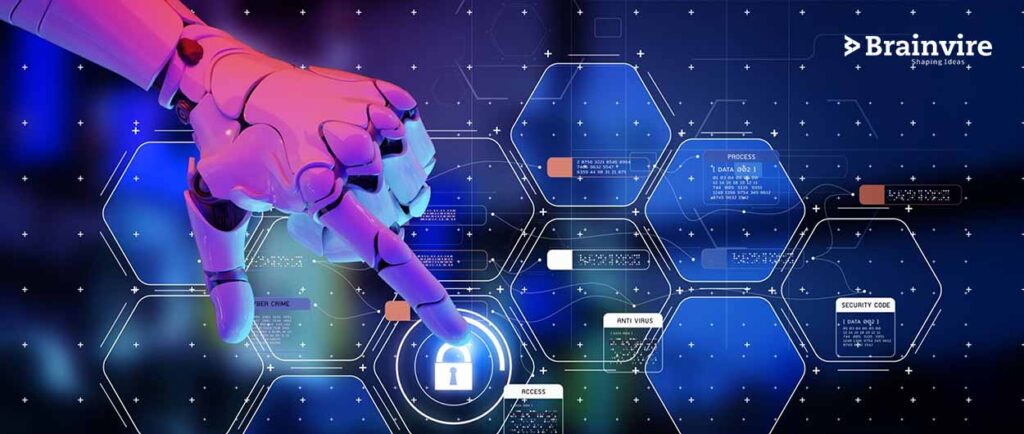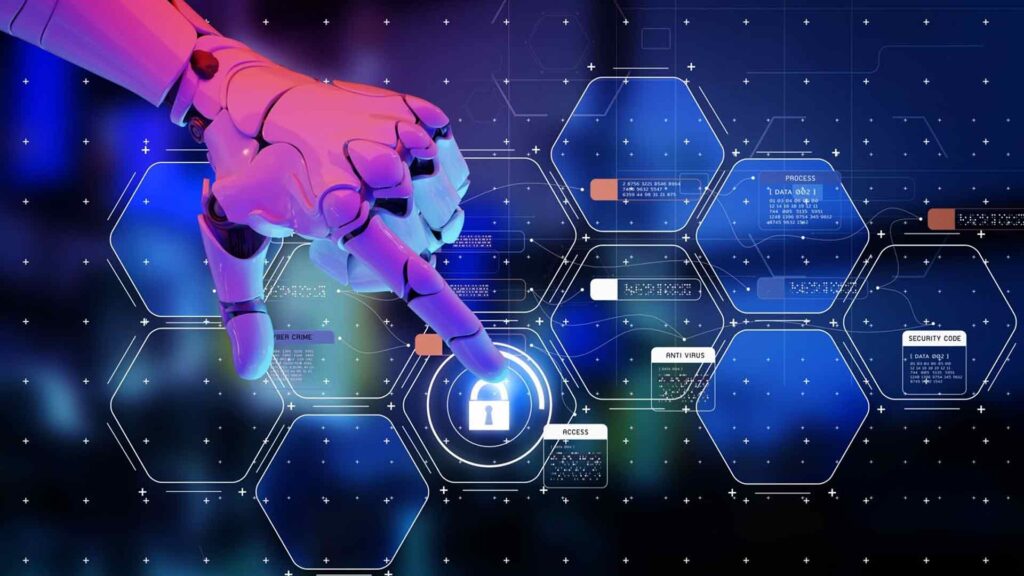Combat Advanced Cyberthreats with the Help of AI and ML:
In early 2020, when virtual communication became the norm, cybercriminals began targeting companies like Zoom. Despite its popularity, Zoom suffered a major data breach that exposed 500,000 user passwords. This incident, coupled with the increasing number of daily cyberattacks, highlights the rising threat of cybercrime faced by businesses today. With sensitive information crossing remote networks and more operations moving online, cybercrime opportunities are abundant and attacks are becoming more sophisticated and difficult to contain.

In 2022, the average cost of a data breach was $4.35M, and it took companies an average of 277 days to identify and contain a breach. These statistics underscore the pressing need for companies of all sizes to invest heavily in cybersecurity.
As companies increasingly adopt AI and machine learning in their operations, concerns have arisen that these technologies may make them more vulnerable to cyber attacks. Some even fear that cybercriminals are already using AI and ML to launch smarter, more sophisticated attacks.
However, there is potential for using Artificial Intelligence and machine learning in cybersecurity responses to combat these threats. By utilizing these technologies, companies may be able to react to and prevent attacks in more sophisticated ways, effectively fighting fire with fire.
The Constant Threat of Cyberattacks
Cyber attacks can take many forms, but data breaches have become a major concern in recent years. According to recent data from Risk Based Security, data breaches in 2020 resulted in the exposure of 36 billion records, with the majority containing personally identifying information (PII). This problem is not unique to Zoom; other major companies like Twitter, Marriott, Easy Jet, and Nintendo have also been affected by data breaches of varying degrees, causing public distrust in technology infrastructures and highlighting concerns about data privacy.
Phishing scams, malware attacks, and IT infrastructure hacks are other common types of cyber attacks that can cause significant disruptions to businesses. Several factors, including the increased reliance on technology, the growth of remote work, and the large amounts of sensitive information being transmitted online, are contributing to the rise in cybercrime. Several factors are contributing to the increase in cybercrime:
- Remote operations leave businesses more vulnerable.
- Geographically distributed employees are working on their own, less secure, networks and devices
- Advancements in ways for hackers to hide their identities make anonymous attacks even easier
- COVID-19 is being used in phishing, malware and ransomware attacks
The growing demand for cybersecurity has led companies to invest more in this area. In 2021, the global cybersecurity market was valued at USD 184.93 billion, and it is predicted to achieve a compound annual growth rate (CAGR) of 12.0% between 2022 and 2030.
The Role of Artificial Intelligence
As businesses increasingly rely on technology, including artificial intelligence (AI) and machine learning (ML), they become more susceptible to cybercrime. These models can be compromised through the data used to train them, potentially allowing for attacks to continue.
Additionally, AI and ML can be reverse engineered to access the data used in their training, further increasing the risk of data breaches. While AI and ML can create vulnerabilities if not used securely, they have also enabled advancements in cybersecurity that help companies detect, identify, and respond to threats more quickly.
As cyber-attacks become more sophisticated, cybersecurity efforts must adapt to keep up with these evolving threats.
Gaining Insight into the Functionality of Artificial Intelligence in Cybersecurity
Artificial intelligence (AI), machine learning (ML), and deep learning models are increasingly being utilized in cybersecurity to develop powerful tools capable of identifying and combatting cyber attacks. These models can analyse data, identify complex patterns within it, and make predictions about future outcomes based on that data.
One of the key advantages of these models is that they are able to learn and adapt over time, becoming increasingly sophisticated and able to not only recognize specific cyber attacks, but also predict potential future attacks.
A common example of ML in cybersecurity is the use of spam filters in email inboxes. By being trained to recognize and identify illegitimate messages, email platforms can alert users to potentially harmful content and unsafe senders.
Within cybersecurity, machine learning algorithms typically focus on three key areas: regression, classification, and clustering. These algorithms are utilized to identify potential threats and determine the appropriate response to them.
Which Machine learning algorithm are used for cybersecurity?
Several machine learning algorithms are used in cybersecurity to identify and respond to threats. Some of the commonly used algorithms include:
Logistic Regression: A type of regression analysis that is used for binary classification problems (i.e., where the output is either a 0 or 1). Logistic regression is commonly used for detecting spam emails and phishing attacks.
Decision Trees: A decision tree is a flowchart-like model that maps out possible outcomes of a decision based on certain conditions. In cybersecurity, decision trees can be used to determine if an event is a security threat or a false positive.
Random Forest: A random forest is an ensemble learning method that combines multiple decision trees. It is used for both classification and regression problems and is often used in intrusion detection systems.
Support Vector Machines (SVMs): SVMs are a type of supervised learning algorithm that can be used for classification and regression analysis. They are commonly used for intrusion detection and identifying malware.
K-Nearest Neighbors (KNN): KNN is a non-parametric algorithm used for classification and regression analysis. It is commonly used in anomaly detection systems.
Neural Networks: Neural networks are a series of algorithms that attempt to recognize patterns in data. They are commonly used in cybersecurity for malware detection, intrusion detection, and vulnerability assessment.
Clustering: Clustering is an unsupervised machine learning technique used to group similar data points together. It can be used in cybersecurity to identify groups of data that may represent an attack or threat.
Overall, machine learning algorithms are becoming increasingly important in cybersecurity, as they can help detect and prevent cyber attacks faster and more accurately than traditional security methods.
Advantages Of Using Ai Within Cybersecurity
There are several advantages of using AI within cybersecurity, including:
- Improved threat detection: AI-powered systems can analyse large amounts of data and identify patterns that may indicate a cyber threat. This can help detect attacks that might otherwise go unnoticed by human analysts.
- Faster response times: AI can automate the process of detecting and responding to cyber threats. This means that responses can be initiated more quickly than if a human analyst had to manually identify and respond to the threat.
- Continuous learning: AI algorithms can learn from previous cyber attacks and use this knowledge to better detect and prevent future attacks. As the system is exposed to more data, it becomes more accurate and efficient at detecting and responding to threats.
- Reduced human error: Humans are prone to making mistakes, particularly when it comes to detecting and responding to complex cyber threats. AI systems can help reduce the risk of human error by automating the process of threat detection and response.
- Cost savings: AI-powered cybersecurity systems can reduce the need for human analysts, which can help organizations save on labour costs. Additionally, these systems can help prevent costly cyber attacks that could result in data breaches or other forms of financial loss.
AI Applications in Cybersecurity in the Real World
- Intrusion Detection: AI algorithms are used to analyse network traffic and identify patterns of behaviour that indicate a possible intrusion. Machine learning models are trained to detect known attack signatures and anomalies, and then automatically block the attacker or alert a security team.
- Malware Detection: AI algorithms can identify malicious code within files and emails by analysing file headers, metadata, and the behaviour of the code. Once the malware is detected, the system can automatically remove or quarantine it.
- Vulnerability Assessment: AI can help identify vulnerabilities in software and networks, using algorithms to scan for misconfigurations and potential security holes. This allows companies to proactively address security issues before they are exploited by attackers.
- User and Entity Behavior Analytics (UEBA): AI algorithms can analyze user behavior on a network, detecting anomalies that may indicate an account has been compromised or an insider threat is present. By using behavioral analytics, companies can better understand normal user behavior and more quickly identify potential threats.
- Fraud Detection: AI can be used to analyze patterns of transactions to identify potential fraud. Industries such as finance, healthcare, and e-commerce benefit from AI fraud detection software to prevent fraudulent activities.
- Facial Recognition :Image and video annotation techniques are utilized to train models in facial recognition technology, enabling them to recognize individual faces and their corresponding identities for a range of applications in cybersecurity. Facial recognition models are utilized to monitor the behavior of specific individuals in security footage. It is also widely used as a personal security measure to unlock smartphones and authorize banking transactions, among other things.
Conclusion
In conclusion, AI is a powerful tool in the fight against cyber threats. By analysing data, detecting complex patterns, and predicting future outcomes based on that data, AI is making it easier for businesses to identify and respond to cyber threats faster than ever before. With the continued growth of AI and its subfields, we can expect to see even more powerful cybersecurity tools in the near future.
Related Articles
-
Top 20 AI Product Description Generator Tools To Use in 2025
Introduction Artificial Intelligence (AI) is revolutionizing businesses’ operations and transforming processes across industries. Among its most impactful applications are AI Product Description Generator tools, which are reshaping how companies handle
-
Unlock Your Podcasting Potential: Top AI Tools Every Podcaster Needs in 2025
Introduction The podcasting landscape is evolving, and AI tools are now essential for podcasters looking to enhance their content, streamline production, and grow their audience. Whether it’s improving sound quality,
-
AI Impact On Medical Diagnostics And Treatment
The medical industry has witnessed a significant transformation due to the remarkable impact of Artificial Intelligence (AI). When doctors successfully save a patient’s life, they are elevated to a status




